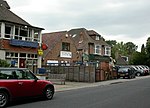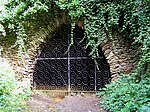River Wey

The River Wey is a main tributary of the River Thames in south east England. Its two branches, one of which rises near Alton in Hampshire and the other in West Sussex to the south of Haslemere, join at Tilford in Surrey. Once combined, the flow is eastwards then northwards via Godalming and Guildford to meet the Thames at Weybridge. Downstream the river forms the backdrop to Newark Priory and Brooklands. The Wey and Godalming Navigations were built in the 17th and 18th centuries, to create a navigable route from Godalming to the Thames. The Wey drains much of south west Surrey (as well as parts of east Hampshire and the north of West Sussex) and has a total catchment area of 904 square kilometres (350 sq mi). Although it is the longest tributary of the Thames (if the Medway is excluded), its total average discharge is lower than that of the Kennet and Cherwell. The river morphology and biodiversity of the Wey are well studied, with many places to take samples and record data. The main tributary is the Tillingbourne, which rises on the western slopes of Leith Hill and flows westwards to join the Wey to the south of Guildford, between Shalford and Peasmarsh. The name Wey is of unknown origin and meaning.
Excerpt from the Wikipedia article River Wey (License: CC BY-SA 3.0, Authors, Images).River Wey
Tilford Street, Waverley Tilford
Geographical coordinates (GPS) Address Nearby Places Show on map
Geographical coordinates (GPS)
| Latitude | Longitude |
|---|---|
| N 51.18 ° | E -0.75 ° |
Address
Stockbridge
Tilford Street
GU10 2DD Waverley, Tilford
England, United Kingdom
Open on Google Maps










